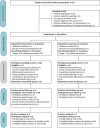The effect of telehealth-based medical nutrition therapy on cardiovascular disease risk factors in a rural population: a secondary analysis of outcomes related to nutrition, health and well-being from the healthy rural hearts randomised controlled trial
- PMID: 41084048
- PMCID: PMC12519800
- DOI: 10.1186/s12966-025-01819-3
The effect of telehealth-based medical nutrition therapy on cardiovascular disease risk factors in a rural population: a secondary analysis of outcomes related to nutrition, health and well-being from the healthy rural hearts randomised controlled trial
Abstract
Background: Adults in rural Australia are at elevated risk of cardiovascular disease (CVD). To date, no intervention trials have evaluated the impact of dietitian delivered nutrition therapy using telehealth exclusively in patients recruited in the primary care setting. The primary aim was to assess effectiveness of telehealth delivered Medical Nutrition Therapy (MNT) on change in dietary intake energy, reported as percent energy derived from nutrient-dense (core) foods. Secondary aims included assessment of the intervention effects on percentage weight loss, quality of life, health literacy and patient engagement in their health (patient activation).
Methods: This was a secondary data analysis of a pragmatic cluster Randomised Controlled Trial (RCT). Adults from rural areas within the New England North West and Upper Hunter regions of New South Wales, Australia, were identified by their general practitioner (GP) following a Heart Health Check, as being at moderate-to-high risk of CVD and invited to participate. General practices were randomised into intervention or usual care groups. Intervention participants received five personalised telehealth MNT consultations over 6 months. Usual care received stand-alone personalised nutrition reports. All participants were managed by their GP and followed up after 12 months. Primary and secondary outcomes were analysed using Bayesian linear mixed models. Models included fixed categorical effects for time, group, group-by-time interaction, age, and sex, with additional predetermined adjustment for variables determined by the literature.
Results: Mean baseline to 12-month increase in percentage of energy from core foods was 7.0% (9.4 SD) for the intervention group and 1.3% (9.6 SD) for usual care group, with an estimated adjusted difference in mean change of 5.9% (95%CI 0.5-11.2). Significant improvements in quality of life (0.04, 95%CI 0.01-0.07) and patient activation were also observed (6.44, 95%CI 0.99-11.83) favouring the intervention group.
Conclusion: A personalised telehealth MNT intervention delivered by dietitians significantly improved percentage energy from nutrient-dense foods amongst rural adults at an elevated risk of CVD. Future research is required to support implementation of telehealth MNT into general practice in rural Australia.
Trial registration: Australian New Zealand Clinical Trials Registry (ACTRN12621001495819).
Keywords: Cardiovascular disease; Diet; Dietitian; Medical nutrition therapy; Primary care; Randomised controlled trial; Rural; Telehealth.
© 2025. The Author(s).
Conflict of interest statement
Declarations. Conflict of interest: The Australian Eating Survey (AES) is a commercial tool available through the University of Newcastle. Ethics approval and consent to participate: This project was conducted in accordance with the Declaration of Helsinki. Ethics approval was gained from the University of Newcastle Human Research Ethics Committee (H-2021–0193) and safety approvals from the University of Newcastle Health and Safety Committee (49/2021). All primary care practices, general practitioners and study participants provided written informed consent to participate in the study.
Figures
References
-
- Australian Institute of Health & Welfare. Australia’s welfare 2021: data insights. Canberra: AIHW; 2021.
-
- Australian Institute of Health & Welfare. Rural and remote health. Canberra: AIHW; 2024.
-
- Australian Bureau of Statistics. 2071.0 - Census of population and housing: reflecting Australia - stories from the census, 2016. Socio-economic advantage and disadvantage Canberra: Australian Bureau of Statistics; 2018 [updated 21 Mar 2023]. Available from: https://www.abs.gov.au/ausstats/abs@.nsf/Lookup/by%20Subject/2071.0~2016....
-
- Australian Institute of Health & Welfare. Mortality over regions and time (MORT) books. Canberra: AIHW; 2024.
Publication types
MeSH terms
Grants and funding
LinkOut - more resources
Full Text Sources
Medical


